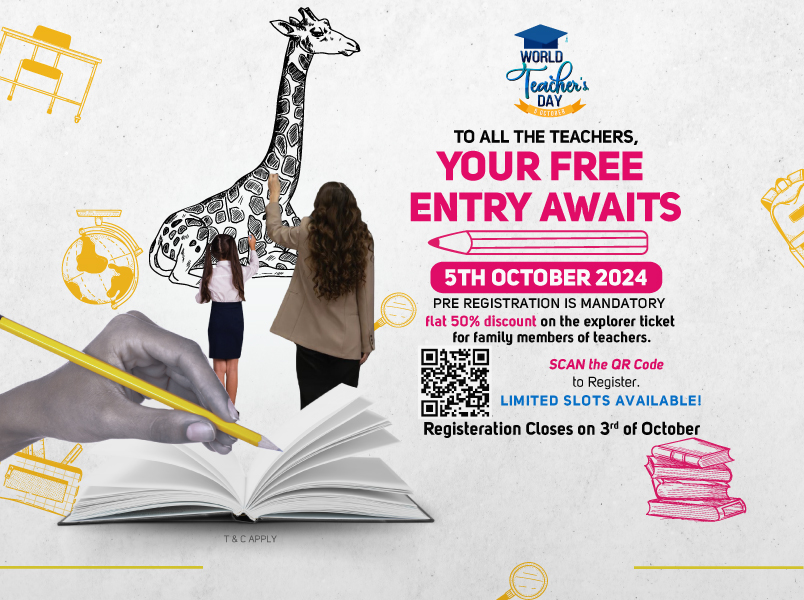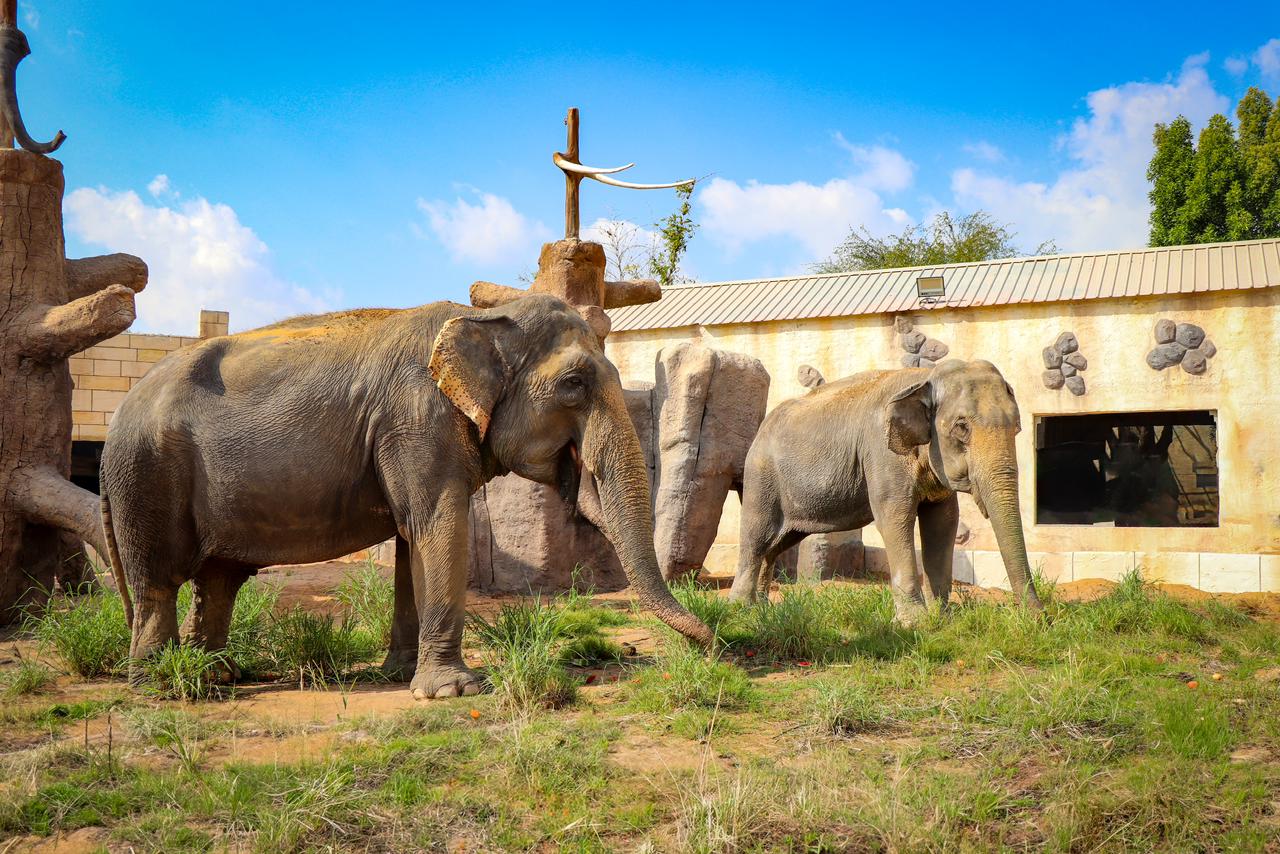Bridging the Gap: Integrating Online and Offline Educational Outreach at Emirates Park Zoo to Transform Public Perception of Zoos
Marsenia Trinanda Haris, Noon Bushra Eltahir Ahmed, Katharina Drucker, Walid Shaaban
Emirates Park Zoo and Resort
Abstract:
Zoological facilities play vital roles in wildlife conservation through breeding programs, education, habitat preservation, and research. However, these efforts are often overshadowed by negative perceptions fuelled by some organizations that generalize the faults of certain zoos, affecting public trust and revenue. Anti-zoo groups depict zoos as entertainment venues that neglect animal welfare, leading to misconceptions that reputable zoos must counter. Emirates Park Zoo's educational outreach program addresses this issue by combining online and offline strategies to reshape public perceptions. The zoo aims to foster a deeper understanding of its conservation efforts and transparency by blending digital engagement through social media, storytelling, and live sessions with direct in-person experiences. The program not only educates the public but also builds trust and counters negative stigma. Future initiatives will likely explore the effectiveness of these methods through surveys and social media analysis, further demystifying zoo operations. The program also emphasizes the importance of collaboration among zoos, suggesting that joint efforts can amplify global educational outreach, combat negative perceptions, and reinforce the critical role zoos play in conservation.
Keywords: Conservation Education, Public Perception, Educational Outreach.
Background:
Zoological institutions play a crucial role in global conservation efforts, engaging in breeding programs, habitat preservation, scientific research, and public education aimed at preserving biodiversity. Modern zoos have transitioned from their historical focus on entertainment to becoming important players in conservation and education (Hosey, Melfi & Pankhurst, 2009). These facilities provide an opportunity for people to engage with wildlife directly, raising awareness about endangered species and the need for conservation.
Despite their positive contributions, zoos continue to face challenges in public perception. Anti-zoo sentiments, often driven by ethical concerns about animal welfare, have resulted in widespread skepticism regarding the role of zoos. Some animal rights organizations accuse zoos of prioritizing profit over the well-being of animals, particularly when highlighting incidents of mistreatment in substandard facilities (Jamieson, 1985; Fraser, 2009). This negative portrayal tends to affect public perception of all zoos, including those that maintain high standards of animal care and play significant roles in conservation (Hutchins, 2008).
To counter these negative perceptions, zoos are increasingly adopting innovative strategies that integrate educational outreach both online and offline. Digital platforms such as social media, live-streamed events, and virtual tours offer zoos an effective way to engage broader audiences and provide transparent information about their operations (Fisher, 2014). These online tools, combined with traditional face-to-face experiences like guided tours, workshops, and educational programs, enhance public understanding of the conservation efforts zoos undertake (Ballantyne, Packer & Hughes, 2009).
Emirates Park Zoo is leveraging such approaches to reshape its public image. Through a comprehensive outreach program, the zoo integrates digital content with on-site experiences, aiming to foster trust and transparency regarding its conservation mission. The zoo’s focus on storytelling and emotional engagement helps visitors connect with wildlife on a deeper level, countering misconceptions and highlighting its role in conservation. The success of this approach will be evaluated through surveys and social media analysis, determining the impact on public perception and educational outcomes.
Methodology:
This study examines the impact of Emirates Park Zoo's educational outreach efforts on public perceptions of zoos and conservation from January to September 2024. It employs a combination of online and offline strategies designed to engage the public, enhance transparency, and promote wildlife conservation.
Online Strategies
- Digital Marketing Campaigns:
Integrated campaigns across radio, TV, and social media highlight the zoo’s conservation programs, focusing on sustainability, biodiversity, and animal welfare. - Live Educational Sessions:
Social media platforms (Instagram) host live sessions with zoo staff, offering insights into conservation programs and breeding efforts, with interactive Q&A for audience engagement. - Interactive Content:
The zoo creates quizzes, videos, and infographics, tailored to different age groups, to educate the public about wildlife conservation and sustainability in a user-friendly format. - Storytelling on social media:
Personalized stories about individual animals and rescue programs are shared to create emotional connections and reshape the perception of zoos.
Offline Strategies
- Guided Tours and Workshops:
Educational tours and workshops led by trained staff provide information on animal biology, conservation, and ecosystem preservation, particularly for school groups. - Animal Encounters and Camps:
Direct interaction with animals fosters empathy and understanding, while seasonal camps for children offer immersive conservation education. - Live Demonstrations:
Practical demonstrations of sustainability practices, such as tree planting and beekeeping, allow visitors to engage with real-world conservation efforts. - Community Initiatives:
Collaborations with schools, universities, and community programs promote active participation in conservation through events like habitat clean-ups.
Data Collection and Analysis:
To evaluate Emirates Park Zoo’s educational outreach efforts, both qualitative and quantitative data were collected using various methods:
- Surveys: Pre- and post-program surveys assessed changes in public perception, knowledge, and attitudes toward conservation after participating in the zoo’s online and offline programs.
- Social Media Metrics: Engagement data (likes, shares, comments, views) from Instagram platforms were analyzed to measure the impact of digital outreach campaigns.
- In-Person Feedback: Feedback from participants in tours, workshops, and camps was gathered to assess educational impact and satisfaction.
Data analysis was conducted using Microsoft Excel 2016 for data visualization and SPSS for advanced statistical analysis, providing insights into the effectiveness of both online and offline strategies.
Results:
Online Engagement:
There is notable increase in participation across the online programs, as indicated by social media engagement metrics. An analysis of Instagram activity revealed that interactive educational content—such as quizzes, behind-the-scenes footage, and zookeeper interviews—generated the highest average number of comments (170.3) and likes (152.88) reflecting strong audience engagement. However, posts related to environmental sustainability attracted the most views (38%), followed by content focused on conservation and animal awareness (17%). These trends, illustrated in Figure 1&2, demonstrate the success of the zoo’s online educational outreach in enhancing public interest and awareness across five key categories of educational content.
Fig. 1: Average views of Instagram Reels
Fig. 2 : Average Instagram Engagement
Offline Strategies:
Changes in Perception
Qualitative feedback from surveys indicates a positive shift in public perception regarding the zoo’s role in conservation. Participants noted increased awareness of the zoo’s conservation and sustainability efforts, particularly after attending in-person programs such as the Bee Experience and Elephant Encounter as shown in Fig 3, 4 and 5.
Fig. 3: The percentage of Transformational Impact in Offline Programs: Bee Experience Program
Fig. 4: Engagement and Informative Level of the Elephant Encounter Experience
Fig. 5: Effectiveness of Conservation Message in Elephant Encounter
Discussion
Emirates Park Zoo’s blended approach of online and offline outreach has proven effective in addressing common misconceptions about zoos and building public trust. By implementing transparency initiatives, such as live-streaming conservation activities and offering behind-the-scenes content, the zoo fosters a stronger connection with the community. These initiatives help demystify zoo operations, showing the vital conservation work happening behind the scenes and emphasizing the zoo’s commitment to animal welfare. As a result, both the online and onsite programs are engaging the public and encouraging greater participation in conservation efforts. In the other hand, one of the major challenges Emirates Park Zoo faces is balancing entertainment with educational content. To keep audiences engaged, the zoo must deliver messages that are not only informative but also captivating, especially on social media where attention spans are limited. Reaching a diverse audience is another hurdle, as the zoo must cater to both local and global communities with varying levels of interest in conservation. Ensuring consistent messaging across these diverse groups requires tailored communication strategies, which can be resource intensive.
Recommendations:
Moving forward, the zoo plans to expand its integration of online and offline strategies to enhance public engagement further. This will involve utilizing advanced social media analytics and participant surveys to measure the effectiveness of their outreach. Additionally, the zoo will broaden its presence on platforms such as Facebook, TikTok, and LinkedIn to reach wider audiences. By refining content based on these insights, the zoo aims to improve the impact of its educational programs. Collaboration with other zoos for joint educational initiatives will also be prioritized, enabling a more unified and far-reaching conservation message to be shared with global audiences.
References:
- Azevedo, F., Kashima, Y., & Zuckerman, M. (2014). Emotions and stereotypes: Intergroup perception and beyond. Psychology Press.
- Ballantyne, R., Packer, J., & Hughes, K. (2009). Tourists’ support for conservation messages and sustainable management practices in wildlife tourism experiences. Tourism Management, 30(5), 658-664.
- Clayton, S., Fraser, J., & Saunders, C. D. (2009). Zoo experiences: Conversations, connections, and concern for animals. Zoo Biology, 28(5), 377-397.
- Croke, V. (1997). The Modern Ark: The Story of Zoos. Scribner.
- Fisher, D. (2014). The internet and the ethics of zoo practices. Society & Animals, 22(5), 486-503.
- Fraser, J. (2009). The Anticipation and the Experience: Zoo Visit Motivations. Visitor Studies, 12(1), 76-89.
- Hosey, G., Melfi, V., & Pankhurst, S. (2009). Zoo Animals: Behaviour, Management, and Welfare. Oxford University Press.
- Hutchins, M. (2008). Challenges and opportunities in the evolving role of zoos in conservation. Zoo Biology, 27(1), 1-12.
- Jamieson, D. (1985). Against zoos. Environmental Ethics, 7(1), 61-70.
- Jacobson, S. K., McDuff, M. D., & Monroe, M. C. (2015). Conservation Education and Outreach Techniques. Oxford University Press.
- Mallinson, J. J. C. (2003). Conservation education: A global imperative. International Zoo Yearbook, 38(1), 1-12.
- Sterling, E. J., Gomez, A., Reining, C., & Gomez, L. (2020). Integrating education and conservation research to advance conservation. Conservation Science and Practice, 2(7), e212.
- World Association of Zoos and Aquariums (WAZA). (2005). Building a Future for Wildlife: The World Zoo and Aquarium Conservation Strategy. WAZA.
Other Packages
Explore All










